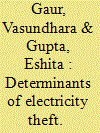| Srl | Item |
| 1 |
ID:
150910


|
|
|
|
|
| Summary/Abstract |
More than 20% of the electricity generated in India is lost to rampant thefts. Drawing data from 28 states of India over a time span of five years (2005–2009), this paper examines the role played by socio-economic and governance factors in determining the extent of electricity thefts in Indian states. Results from the Feasible Generalised Least Squares (FGLS) model demonstrate that lesser corruption, higher state tax to GDP ratio, greater collection efficiency of electricity bills by state utilities, higher share of private installed capacity, lesser poverty, greater literacy and greater income are closely associated with lesser power thefts. A better understanding of the key determinants of thefts in electricity distribution is vital for policy makers for designing policies.
|
|
|
|
|
|
|
|
|
|
|
|
|
|
|
|
| 2 |
ID:
176876


|
|
|
|
|
| Summary/Abstract |
The present study offers a novel approach in measuring Household Energy Poverty Index (HEPI) using National Sample Survey unit level data, employing a robust set of 15 key energy indicators representing multiple dimensions of energy and assigning weights by using principal component analysis (PCA). Grouping households into four different categories such as ‘least energy poor’, ‘less energy poor’, ‘more energy poor’ and ‘most energy poor’, it emerges from the study that more than 1/4th of total households in the country, falls under ‘most energy poor’ category, and 65% households in the country are in the ‘more and most energy poor’ groups implying the wide-scale prevalence of energy poverty in the country. In addition, analysis based on geographical spread of energy poverty reveals that eastern states and north-eastern states are more vulnerable in terms of energy poverty, hence requires strategic policy actions at all layers of governance. The HEPI can form a rigorous analytical basis for energy policy making in India – both the federal scale as well as at the state level.
|
|
|
|
|
|
|
|
|
|
|
|
|
|
|
|
| 3 |
ID:
166533


|
|
|
|
|
| Summary/Abstract |
This paper seeks to identify the causal impact of solar water pumps on the consumption of water, electricity and diesel as well as the gross cropped area under fruits and vegetables and profits of farmers. We use the difference-in-differences approach with a sample of 414 rural farmers from six districts of Rajasthan for this purpose. We find that the adoption of the solar water pump has impacted energy-water-food nexus by increasing average groundwater consumption of adopters over baseline in the districts of Jaipur and Sikar by 16–39%; reducing average electricity consumption of adopters over baseline in Jaipur and Sikar by 1–17% and in Sri Ganganagar by 17–134%; reducing average diesel consumption in Bikaner, Jaisalmer, Sri Ganganagar and Chittorgarh by 50–106%; increasing food security of adopters as indicated by an increase in average cropping intensity in Jaipur and Sikar by 2–10% and in Bikaner by 2–9%, and expansion in gross cropped area under fruits and vegetables in Jaipur by 12–53% and Bikaner by 10–116%; increasing income security with higher annual profits for solar pump adopters in Jaipur and Sikar by 3.1–41.5% and in the diesel-using districts by 14–76%.
|
|
|
|
|
|
|
|
|
|
|
|
|
|
|
|